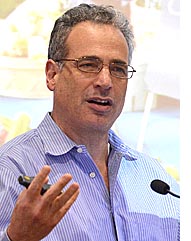Shifting money to ‘Main Street’
- Published: November 2, 2017
Could local investing be a tool for strengthening the Yellow Springs economy?
Community economist Michael Shuman thinks so. Shuman spoke recently at Community Solutions’ 64th conference, “Economics of Happiness,” held in Yellow Springs. He was among about a dozen conference speakers who discussed how to build stronger, more vibrant local economies to meet human and ecological needs. In addition to Shuman, keynote speakers included writer Charles Eisenstein and localization activist Helena Norberg-Hodge, whose organization, Local Futures, co-sponsored the conference. About 180 people attended, according to Community Solutions Executive Director Susan Jennings.

Michael Shuman was among about a dozen speakers at Community Solutions’ 64th conference, “Economics of Happiness,” held in Yellow Springs Oct. 20-21. Shuman spoke on local investing and the vital role of locally owned and supported businesses. (Submitted photo)
Shuman presented a workshop on Saturday afternoon focused on local investing, as well as speaking on related themes earlier in the day. In basic terms, an investment is something a person or organization puts money toward in hopes of a return. Individuals might invest in a house or an education, or put money into a savings account or the stock market, Shuman said. Buying a house is a great form of local investment, he said. But how can a person with savings put money into local businesses — into local people and jobs — rather than buying bonds or stock that benefit a global corporation?
New laws make that possible, according to Shuman. In 2012, President Obama signed the Jumpstart Our Business Startups, or JOBS, Act, which Shuman helped architect. The act allows ordinary people — not just so-called “accredited investors,” or people with high income and wealth — to invest in small businesses, Shuman explained.
“This proposal was all about making it easier for local, small-scale investing,” he said in a 2015 interview on the website Community-Wealth.org.
The recent rise of crowdfunding, in which businesses raise start-up capital through modest investments gathered online, is one example of the kind of activity the new law allows.
Shuman described a study he and other researchers did about seven years ago, looking at what would happen if there were just a 25 percent shift toward local food in the Cleveland area. What if the local food economy — encompassing the growing, processing and retailing of food — grew by a modest amount, replacing just a portion of the global food economy in metro Cleveland, the study asked. The result would be a massive increase in new jobs, tax revenue and wages, Shuman and his study co-authors found.
“Even a small shift of money from Wall Street to Main Street can make a huge difference,” Shuman said at the conference, to applause.
But most investors still favor global corporations, by putting their money into big banks or buying shares of Fortune 500 companies. That can change, Shuman said.
“Move your money into a local bank or credit union,” he advised on Saturday, noting that small banks on average give 56 percent of their loans to local businesses, while big banks only give 18 percent.
That message was music to Sandy Hollenberg’s ears. CEO of Yellow Springs Federal Credit Union, or YSFCU, Hollenberg said this week she was excited by the ideas presented at the conference. The credit union already facilitates a small amount of local investing and would like to do more, she said. For example, it has several arrangements in place that tie local investors’ savings deposits to lines of credit or loans that benefit local organizations. In fact, such an arrangement helped Community Solutions purchase the land for Agraria, its sustainable agriculture project, and continues to support that undertaking.
The linkage between deposits and lines of credit or loans “allows community businesses to be supported by community investors,” she said.
The local credit union recently earned Community Development Financial Institution, or CDFI, certification, Hollenberg told conference attendees during the Q&A session following Shuman’s workshop. That certification “increases our role in community impact investing,” she said. Among other things, the designation gives YSFCU access to grant money that could potentially be used as collateral to make small business loans, expanding its role in the local economy.
Conference attendee and Village Council member Marianne MacQueen was also energized by Shuman’s ideas. Yellow Springs has long been caught between those who favor an economic development strategy of bringing in mid-sized businesses from the outside, and those who resist such efforts for a variety of reasons, she said this week. A focus on growing local businesses could be one way out of that conflict.
“It’s been seen as pie-in-the-sky. But it can be done,” she said. “Changes are happening that are giving us more tools for local investment.”
Understanding local business opportunities and needs — including needs for start-up capital — is a key first step, so MacQueen would like to see a local business survey focused on those issues. Beefing up the Village’s Economic Development Revolving Loan Fund could be useful, but as Shuman’s presentation emphasized, finding ways to utilize capital from individual investors to support local businesses is also a powerful tool, she said.
Shuman said in a follow-up interview this week that grassroots investing is just beginning to take off. In any community that has significant numbers of retired people with savings income, there is an especially great opportunity to “identify and mobilize those assets” to support local business creation, he said.
Local investing gets equal or better returns as compared to investing in Wall Street, he said. There’s more risk in some ways, but less in others. And while the private rate of return — that is, the financial gains a person realizes from an investment — is about the same for investing locally versus investing in the Fortune 500, there’s a big difference in the social rate of return.
“Investing locally, you have a lot of impact in the community where you live,” he said. Invest in Wall Street, and the impact on your community’s social and economic well-being is “zero,” he added.
Municipalities can embrace local investing, too, he said, by banking at a local bank; keeping a list of local businesses that are looking for capital on their municipal website; issuing local bonds that allow citizens to invest in bond issues for municipal projects; and making sure goods and services are sourced locally.
The goal is to help local businesses arise and thrive, and keep money circulating within a community.
Locally owned businesses help create more vibrant, more economically just local economies, Shuman explained. A 2013 study done by the Federal Reserve suggests that U.S. counties with the highest density of locally owned business are also those with the highest per capita income growth rate.
Focusing economic development efforts on growing and retaining local businesses is one way to reduce income inequality, Shuman said.
And that is good for Main Street — and Xenia Avenue.
The Yellow Springs News encourages respectful discussion of this article.
You must login to post a comment.
Don't have a login? Register for a free YSNews.com account.
Parkinsons.jpg)














No comments yet for this article.